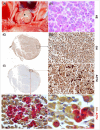Hypersomatotropism and Hypercortisolism Caused by a Plurihormonal Pituitary Adenoma in a Dog
- PMID: 40524601
- PMCID: PMC12171238
- DOI: 10.1111/jvim.70177
Hypersomatotropism and Hypercortisolism Caused by a Plurihormonal Pituitary Adenoma in a Dog
Abstract
A 12-year-old, male Labrador Retriever was presented because of polyuria, polydipsia, polyphagia, joint pain, and physical features consistent with acromegaly. Circulating insulin-like growth factor-1 (IGF-1) concentration was increased (> 1000 ng/mL; reference interval [RI], 42-449), suggestive of hypersomatotropism. An abnormal low-dose dexamethasone suppression test and increased circulating adrenocorticotropic (ACTH) concentration indicated pituitary-dependent hypercortisolism. Computed tomography identified an enlarged pituitary gland. Treatment with cabergoline initially decreased circulating IGF-1 and ACTH concentrations and urinary cortisol-to-creatinine ratio (UCCR), with a notable reduction in acromegalic physical features. However, 7 months after the start of cabergoline treatment, IGF-1, ACTH, and UCCR had increased again, although pituitary gland size remained stable. Because of worsening joint pain, euthanasia was performed. On necropsy, double immunohistochemistry identified pituitary tumor cells with cytoplasmic co-expression of both growth hormone (GH) and ACTH, consistent with a monomorphic plurihormonal macroadenoma. This case shows that concurrent hypersomatotropism and hypercortisolism can occur in dogs caused by a plurihormonal pituitary adenoma.
Keywords: acromegaly; caber goline; corticotropinoma; cushing's syndrome; growth hormone; insulin‐like growth factor‐1; somatotropinoma.
© 2025 The Author(s). Journal of Veterinary Internal Medicine published by Wiley Periodicals LLC on behalf of American College of Veterinary Internal Medicine.
Conflict of interest statement
The authors declare no conflicts of interest.
Figures





Similar articles
-
Plurihormonal ACTH-GH Pituitary Adenoma: Case Report and Systematic Literature Review.World Neurosurg. 2018 Jun;114:e158-e164. doi: 10.1016/j.wneu.2018.02.120. Epub 2018 Mar 6. World Neurosurg. 2018. PMID: 29501516
-
Somatotroph and corticotroph pituitary adenoma (double adenoma) in a cat with diabetes mellitus and hyperadrenocorticism.J Comp Pathol. 2004 Feb-Apr;130(2-3):209-15. doi: 10.1016/j.jcpa.2003.09.004. J Comp Pathol. 2004. PMID: 15003481
-
Dopamine receptor expression predicts cabergoline response in persistent somatotroph adenoma.Pituitary. 2025 Jul 23;28(4):87. doi: 10.1007/s11102-025-01556-7. Pituitary. 2025. PMID: 40702399
-
A multihormonal pituitary adenoma with growth hormone and adrenocorticotropic hormone production, causing acromegaly and Cushing disease.Am J Med Sci. 2002 Dec;324(6):326-30. doi: 10.1097/00000441-200212000-00007. Am J Med Sci. 2002. PMID: 12495300
-
Pheochromocytoma associated with ectopic ACTH-producing tumor and hyper-interleukin-6emia: a case report with review of literature.Endocr J. 2025 Jun 2;72(6):743-750. doi: 10.1507/endocrj.EJ24-0459. Epub 2025 Feb 14. Endocr J. 2025. PMID: 39956584 Free PMC article. Review.
References
-
- Kooistra H. S., “Chapter 40—Acromegaly in Dogs,” in Clinical Endocrinology of Companion Animals, 1st ed., ed. Rand J. (Wiley, 2013), 421–426.
-
- Selman P. J., Mol J. A., Rutteman G. R., van Garderen E., and Rijnberk A., “Progestin‐Induced Growth Hormone Excess in the Dog Originates in the Mammary Gland,” Endocrinology 134 (1994): 287–292. - PubMed
-
- Jaillardon L., Martin L., Nguyen P., and Siliart B., “Serum Insulin‐Like Growth Factor Type 1 Concentrations in Healthy Dogs and Dogs With Spontaneous Primary Hypothyroidism,” Veterinary Journal 190 (2011): e95–e99. - PubMed
-
- Daly A. F. and Beckers A., “Chapter 12—Medical Management of Pituitary Gigantism and Acromegaly,” in Gigantism and Acromegaly, 1st ed., ed. Stratakis C. A. (Academic Press, Elsevier, 2021), 245–257.
-
- van Keulen L. J., Wesdorp J. L., and Kooistra H. S., “Diabetes Mellitus in a Dog With a Growth Hormone‐Producing Acidophilic Adenoma of the Adenohypophysis,” Veterinary Pathology 33 (1996): 451–453. - PubMed
Publication types
MeSH terms
Substances
LinkOut - more resources
Full Text Sources
Medical
Miscellaneous

